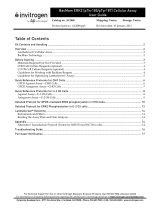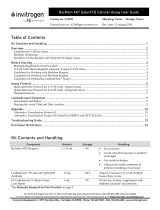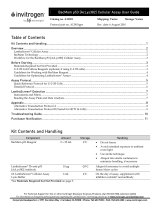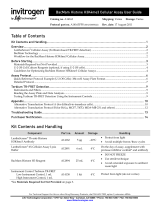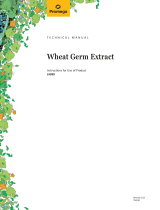Page is loading ...

LanthaScreen® Kinase Binding Assay User Guide
Catalog nos. various (see page 3) Shipping: Dry Ice Storage: –20°C
Protocol part no. PV5592.pps Rev. date: 16 April 2010
For Technical Support for this or other Invitrogen Discovery Sciences Products, dial 760 603 7200, select option 3, extension 40266
For information on frequently asked questions regarding the LanthaScreen™ technology, please go to www.invitrogen.com/lanthascreen
Corporate Headquarters • 5791 Van Allen Way • Carlsbad, CA 92008 • Phone: 760 603 7200 • FAX: 760 602 6500 • www.invitrogen.com
Table of Contents
1. Overview ...................................................................................................................................................................1
2. Principle of LanthaScreen® Eu Kinase Binding Assays......................................................................................2
3. Materials....................................................................................................................................................................3
3.1 Kinase Tracers........................................................................................................................................................................3
3.2 Additional Assay Reagents......................................................................................................................................................3
3.3 Plate Readers..........................................................................................................................................................................4
3.4 Plate Selection ........................................................................................................................................................................4
4. Basic Protocol for Inhibitor Studies.......................................................................................................................5
5. Procedures ...............................................................................................................................................................6
5.1 Optimization of Tracer Concentration......................................................................................................................................6
5.2 Inhibitor Titration......................................................................................................................................................................9
6. Alternate Method to Determine Tracer Kd and Ki Values...................................................................................11
7. References..............................................................................................................................................................14
1. Overview
This user guide describes how to perform a LanthaScreen® Eu Kinase Binding Assay designed to detect and characterize
kinase inhibitors. The first procedure (Section 5.1) is an optional experiment to optimize the concentration of tracer to use with
a specific kinase target. This step is not necessary when using conditions established for Invitrogen kinases (see
www.invitrogen.com/bindingassaytable for a list). The second procedure (Section 5.2) describes how to perform kinase
inhibitor affinity (IC50) measurements using either the concentration of tracer determined by the user or using the
concentration determined experimentally by Invitrogen. Each experimental method is accompanied by example data for a
diverse set of kinases.
A growing list of Invitrogen kinases have been validated for use with the LanthaScreen® Eu Kinase Binding Assay. For
detailed assay conditions and validation data for specific kinases, visit www.invitrogen.com/bindingassaytable.

Invitrogen LanthaScreen® Kinase Binding Assay User Guide Page 2 of 14
For Technical Support for this or other Invitrogen Discovery Sciences Products, dial 760 603 7200, select option 3, extension 40266
For information on frequently asked questions regarding the LanthaScreen® technology, please go to www.invitrogen.com/lanthascreen
Corporate Headquarters • 5791 Van Allen Way • Carlsbad, CA 92008 • Phone: 760 603 7200 • FAX: 760 602 6500 • www.invitrogen.com
2. Principle of LanthaScreen® Eu Kinase Binding Assays
LanthaScreen® Kinase Binding Assays are based on the binding and displacement of a proprietary, Alexa Fluor® 647-labeled,
ATP-competitive kinase inhibitor scaffold (kinase tracer) to the kinase of interest. Tracers based on a variety of scaffolds have
been developed to address a wide range of kinase targets. Binding of the tracer to the kinase is detected using a europium-
labeled anti-tag antibody, which binds to the kinase of interest. Simultaneous binding of both the tracer and antibody to the
kinase results in a high degree of fluorescence resonance energy transfer (FRET) from the europium (Eu) donor fluorophore to
the Alexa Fluor® 647 acceptor fluorophore on the kinase tracer. Binding of an inhibitor to the kinase competes for binding with
the tracer, resulting in a loss of FRET.
The kinase tracers are based on ATP-competitive kinase inhibitors, and are thus suitable for detecting any compound that
binds to the ATP site (Type I or Type II inhibitor). They can even detect most compounds that are not ATP competitive (Type
III/allosteric inhibitors). Almost all non-ATP competitive (Type III) inhibitors tested to date displace the tracers, indicating
that they either bind close to the ATP site or induce a conformational change at the ATP site. Out of 15 diverse commercially
available Type III compounds tested against their respective targets, 14 displaced the tracer with a competency comparable to
published assays. Notable examples of Type III compounds detected include GNF-2 (Abl), BMS-345541 (IKK beta), and MK-
2206 (AKT). The only compound class tested to date that was not detected, with a single example, is purely peptide/protein
substrate competitive (e.g., MK2a inhibitor), and thus not truly allosteric.
In contrast to most fluorescence-based kinase activity assays, LanthaScreen® Eu Kinase Binding Assays can be read
continuously, which facilitates evaluation of compounds with slow binding kinetics. Also, unlike most activity assays, the
assay can be performed using either active or inactive kinase preparations, which enables characterization of compounds that
bind preferentially to inactive kinases (e.g. Gleevec®/imatinib).
Figure 1. Schematic of LanthaScreen™ Eu Kinase Binding Assay.

Invitrogen LanthaScreen® Kinase Binding Assay User Guide Page 3 of 14
For Technical Support for this or other Invitrogen Discovery Sciences Products, dial 760 603 7200, select option 3, extension 40266
For information on frequently asked questions regarding the LanthaScreen® technology, please go to www.invitrogen.com/lanthascreen
Corporate Headquarters • 5791 Van Allen Way • Carlsbad, CA 92008 • Phone: 760 603 7200 • FAX: 760 602 6500 • www.invitrogen.com
3. Materials
3.1 Kinase Tracers
Product Quantity Composition Catalog no. Storage
Kinase Tracer 236 25 μL Solution of 50 μM Tracer in DMSO PV5592 –20°C
Kinase Tracer 178 25 μL Solution of 25 μM Tracer in DMSO PV5593 –20°C
Kinase Tracer 199 25 μL Solution of 25 μM Tracer in DMSO PV5830 –20°C
Kinase Tracer 314 25 μL Solution of 25 μM Tracer in DMSO PV6087 –20°C
Kinase Tracer 1710 25 μL Solution of 25 μM Tracer in DMSO PV6088 –20°C
3.2 Additional Assay Reagents
The Eu-anti-tag antibodies are supplied at approximately 0.22 to 0.28 mg/mL. The molecular weight of each
antibody is 150 kD. The stock concentration of each antibody can be calculated by dividing the concentration in
mg/mL by the molecular weight.
Important: Prior to use, the antibody tube should be centrifuged at approximately 10,000 × g for 10 minutes, and the
solution needed for the assay should be aspirated from the top of the solution. This centrifugation step will eliminate
spurious data points that can arise due to any particulates in the product.
Product Quantity Composition Catalog no. Storage
LanthaScreen® Eu-
anti-GST Antibody
25 μg Approximately 0.25 mg/mL
(see certificate of analysis for lot-specific concentration)
PV5594 –20°C
LanthaScreen® Eu-
anti-GST Antibody
1 mg Approximately 0.25 mg/mL
(see certificate of analysis for lot-specific concentration)
PV5595 –20°C
LanthaScreen® Eu-
anti-His Antibody
25 μg Approximately 0.25 mg/mL
(see certificate of analysis for lot-specific concentration)
PV5596 –20°C
LanthaScreen® Eu-
anti-His Antibody
1 mg Approximately 0.25 mg/mL
(see certificate of analysis for lot-specific concentration)
PV5597 –20°C
Biotin anti-His Tag
Antibody
25 μg Approximately 0.25 mg/mL
(see certificate of analysis for lot-specific concentration)
PV6089 –20°C
Biotin anti-His Tag
Antibody
1 mg Approximately 0.25 mg/mL
(see certificate of analysis for lot-specific concentration)
PV6090 –20°C
LanthaScreen® Eu-
anti-DYKDDDDK
25 μg Approximately 0.25 mg/mL
(see certificate of analysis for lot-specific concentration)
PV6026 –20°C
LanthaScreen® Eu-
anti-DYKDDDDK
1 mg Approximately 0.25 mg/mL
(see certificate of analysis for lot-specific concentration)
PV6027 –20°C
5X Kinase Buffer A 4 mL 250 mM HEPES pH 7.5, 0.05% Brij-35, 50 mM MgCl2,
and 5 mM EGTA
PV3189 20–30°C
Kinase Visit www.invitrogen.com/kinase for ordering information for specific kinases

Invitrogen LanthaScreen® Kinase Binding Assay User Guide Page 4 of 14
For Technical Support for this or other Invitrogen Discovery Sciences Products, dial 760 603 7200, select option 3, extension 40266
For information on frequently asked questions regarding the LanthaScreen® technology, please go to www.invitrogen.com/lanthascreen
Corporate Headquarters • 5791 Van Allen Way • Carlsbad, CA 92008 • Phone: 760 603 7200 • FAX: 760 602 6500 • www.invitrogen.com
3.3 Plate Readers
In general, instruments, instrument settings, and filters that work with other europium-based TR-FRET assay
systems will perform well with the LanthaScreen® Eu Kinase Binding Assay. As with other TR-FRET systems, the
europium donor is excited using a 340-nm excitation filter with a 30-nm bandpass. Energy transfer to the Alexa
Fluor® 647 tracer is measured using a filter centered at 665 nm with a 10 nm bandpass, and this signal is referenced
(or “ratioed”) to the emission from europium peak, using a 615 nm, 10-nm bandpass filter. The “emission ratio” is
calculated as the 665 nm signal divided by the 615 nm signal. The assay can be performed on a variety of plate
readers including those from Tecan (Ultra, Infinite F-500, Safire2), Molecular Devices (Analyst and M5), BMG
LABTECH (PHERAstar) and Perkin Elmer (EnVision, Victor, and ViewLux) or any other plate reader configured for
LANCE® or HTRF® assays. Guidelines provided by the instrument manufacturer for Europium-based TR-FRET
assays can also be used as a starting point for optimization.
Ask your Invitrogen representative for instrument-specific setup guidelines, or contact Invitrogen Discovery Sciences
Technical Support at 800-955-6288 (select option 3 and enter 40266), or email tech_support@invitrogen.com for more
information on performing LanthaScreen® assays on your particular instrument.
3.4 Plate Selection
Assays are typically performed in white low-volume 384-well plates (Corning 3673 or Greiner 784207) or black, low-
volume 384-well plates (Corning 3676). White plates are generally recommended as they yield higher quality data for
many assays, especially those with a relatively low assay window (1.5 to 2 fold) or those that are being measured on
monochromater-based instruments or some filter-based instruments (e.g. Perkin Elmer EnVision®). In other cases,
black and white plates yield comparable data.

Invitrogen LanthaScreen® Kinase Binding Assay User Guide Page 5 of 14
For Technical Support for this or other Invitrogen Discovery Sciences Products, dial 760 603 7200, select option 3, extension 40266
For information on frequently asked questions regarding the LanthaScreen® technology, please go to www.invitrogen.com/lanthascreen
Corporate Headquarters • 5791 Van Allen Way • Carlsbad, CA 92008 • Phone: 760 603 7200 • FAX: 760 602 6500 • www.invitrogen.com
4. Basic Protocol for Inhibitor Studies
LanthaScreen® Kinase Binding Assays to evaluate inhibitors are typically performed by addition of three components, each at
3X the final desired concentration as follows:
1. Add 5 μL of test compound.
2. Add 5 μL of kinase/antibody mixture.
3. Add 5 μL of tracer.
4. Incubate for 1 hour at room temperature and read plate.
The final assay conditions are typically as follows:
5 nM kinase1
2 nM Eu-anti-tag Antibody2,3
1–100 nM Kinase Tracer 178, 199, 236, 314, or 17104
1X Kinase Buffer A
Notes:
1A kinase concentration of 5 nM kinase is recommended as a starting point for assay development, as it typically results in a
robust signal. Decreasing the kinase concentration may be necessary for accurate measurement of very tight-binding
inhibitors, similar to kinase activity assays. For specific test cases, successful assays have been performed with at little as 200
pM kinase, though the assay window may be lower.
2Eu-anti-His, Eu-anti-GST, or Eu-anti-DYKDDDDK
3Alternatively, for his-tagged kinases, 2 nM Eu-streptavidin and 2 nM biotin-anti-His may be used
4Optimal tracer concentrations for all validated kinases typically fall within the 1–100 nM range

Invitrogen LanthaScreen® Kinase Binding Assay User Guide Page 6 of 14
For Technical Support for this or other Invitrogen Discovery Sciences Products, dial 760 603 7200, select option 3, extension 40266
For information on frequently asked questions regarding the LanthaScreen® technology, please go to www.invitrogen.com/lanthascreen
Corporate Headquarters • 5791 Van Allen Way • Carlsbad, CA 92008 • Phone: 760 603 7200 • FAX: 760 602 6500 • www.invitrogen.com
5. Procedures
5.1 Optimization of Tracer Concentration
Note: When using an Invitrogen kinase for which an assay protocol exists (see
www.invitrogen.com/bindingassaytable), this procedure is not necessary. You can proceed directly to
Section 5.2.
This procedure describes how to optimize the tracer concentration for use in subsequent inhibitor studies by
performing binding assays with a 2-fold serial dilution of tracer. This experiment allows for approximation of the
tracer dissociation constant (Kd) and evaluation of the signal strength or “assay window” as a function of tracer
concentration. It is typically best to select a tracer concentration near Kd or below Kd to ensure sensitive detection of
inhibitors. For example, the measured IC50 value from a simple compound titration will approach Ki (dissociation
constant of a competitive inhibitor) if [tracer] < tracer Kd and [kinase] << [tracer].
The majority of kinase assays validated by Invitrogen yield a robust signal with the tracer no more than twice the Kd
value. In many cases, the Kd value can also be used to calculate Ki from a compound titration experiment using the
Cheng-Prusoff equation as detailed in Section 5.2, which compensates for the tracer concentration being above Kd.
The other factor to consider when selecting a tracer concentration is the signal strength or “assay window” as it
correlates very well with assay robustness (i.e. Z’ values). Although in many cases assay windows can exceed 10-fold,
excellent Z’ values are typically obtained with an assay window as low as 2-fold (see Section 6). The specific end
application may also impact the choice of tracer concentration, based on both the assay window, Z’, and Kd value.
The relatively simple method to determine tracer Kd described in this section is supported by data from an alternative
method to calculate Kd (in addition to Ki) as described in Section 6. This alternative method is based on a series of
inhibitor titrations performed at different tracer concentrations and the resulting Kd values correlate well with those
derived using the more rapid method described below.
5.1.1 Tracer Preparation
1. For Kinase Tracers 178, 199, 314, or 1710: Dilute tracer to 3000 nM by mixing 7.2 μL of 25 μM stock
tracer with 53 μL 1X Kinase Buffer A.
For Kinase Tracer 236: Dilute tracer to 3000 nM by mixing 3.6 μL of 50 μM stock tracer with 56 μL 1X
Kinase Buffer A.
2. Add 50 μL of 1X Kinase Buffer A to 6 wells in each of 2 columns of a 96-well plate.
3. Add 50 μL of 3000 nM tracer to well A1 and mix.
4. Remove 50 μL from well A1, transfer to well A2 and mix.
5. Remove 50 μL from well A21, transfer to well B1 and mix.
6. Continue as depicted in Figure 2.

Invitrogen LanthaScreen® Kinase Binding Assay User Guide Page 7 of 14
For Technical Support for this or other Invitrogen Discovery Sciences Products, dial 760 603 7200, select option 3, extension 40266
For information on frequently asked questions regarding the LanthaScreen® technology, please go to www.invitrogen.com/lanthascreen
Corporate Headquarters • 5791 Van Allen Way • Carlsbad, CA 92008 • Phone: 760 603 7200 • FAX: 760 602 6500 • www.invitrogen.com
Column 1
Column 2
A
B
C
D
E
F
Serial dilution of tracer
in Kinase Buffer A
Figure 2. Serial dilution of tracer.
5.1.2 Kinase/Antibody Solution Preparation
1. Centrifuge antibody stock in a microfuge at approximately 10,000 × g for 10 minutes. Prepare a 1 mL
solution of 6 nM antibody and 15 nM kinase. When using biotin-anti-His, 6 nM Eu-streptavidin should
also be included.
2. Prepare competitor solution by diluting a known inhibitor to 30 μM in Kinase Buffer A, typically from a
10 mM stock in DMSO. A suitable competitor for specific kinases validated by Invitrogen can be found
in the Validation Packets at www.invitrogen.com/bindingassaytable.
3. Prepare DMSO control solution by adding DMSO to Kinase Buffer to the same DMSO concentration as
in the competitor solution (typically 0.3%).
5.1.3 Experimental Procedure
1. Add 5 μL each concentration of serially diluted tracer to six replicate assay wells (columns 1–6) (Fig. 3).
2. Add 5 μL competitor solution to three wells for each tracer concentration (columns 1–3).
3. Add 5 μL Kinase Buffer (with 3% DMSO) to the other three wells for each tracer concentration
(columns 4–6).
4. Add 5 μL kinase/antibody solution to all wells in columns 1–6.
5. Incubate the plate at room temperature for 60 minutes and read.

Invitrogen LanthaScreen® Kinase Binding Assay User Guide Page 8 of 14
For Technical Support for this or other Invitrogen Discovery Sciences Products, dial 760 603 7200, select option 3, extension 40266
For information on frequently asked questions regarding the LanthaScreen® technology, please go to www.invitrogen.com/lanthascreen
Corporate Headquarters • 5791 Van Allen Way • Carlsbad, CA 92008 • Phone: 760 603 7200 • FAX: 760 602 6500 • www.invitrogen.com
Assay plate
(384-Well) Assay plate
(384-Well)
Column 1
A
B
C
D
E
F
Column 2
A
B
C
D
E
F
AB
Figure 3. Transfer of tracer dilutions from 96-well to 384-well plate.
5.1.4 Data Analysis
1. Divide the acceptor/tracer emission (665 nM) by the antibody/donor emission (615 nM) to calculate the
emission ratio.
2. Plot [tracer] versus emission ratio for the competitor and control (DMSO only). The sigmoidal dose-
response curve with a variable slope can be fit to the data (optional). The following equation can be
used with GraphPad™ Prism software:
F=50
logEC50=logECF-(1/HillSlope)*log(F/(100-F))
Y=Bottom+(Top-Bottom)/(1+10^((LogEC50-X)*HillSlope))
3. Divide the signal in the absence of competitor by the signal in the presence of competitor to calculate
the “assay window” at each concentration of tracer. The assay window correlates well with assay
robustness (Figure 4), with assay windows of greater than 1.5 generally yielding Z’-factors of >0.5 while
the majority of assays have Z’-factors of >0.75. Assay windows beyond 3 or 4 typically do not result in
an increase Z’-factor. These data, combined with the Kd determined below, are helpful in selecting an
optimal tracer concentration.
110
0.0
0.1
0.2
0.3
0.4
0.5
0.6
0.7
0.8
0.9
1.0
3
245 20 30 40 50
Assay Window
Z'-factor
Figure 4. Assay Window Plotted Against Z’-Factor.
4. Subtract the competitor curve (+competitor) from the control curve (DMSO only) to correct for
background signal, which is typically due to diffusion enhanced FRET from Eu to unbound tracer.
5. Plot the background-corrected emission ratios versus [tracer] and fit to the one site binding (hyperbola)
equation to estimate the dissociation constant. The following equation can be used with GraphPad™
Prism software:

Invitrogen LanthaScreen® Kinase Binding Assay User Guide Page 9 of 14
For Technical Support for this or other Invitrogen Discovery Sciences Products, dial 760 603 7200, select option 3, extension 40266
For information on frequently asked questions regarding the LanthaScreen® technology, please go to www.invitrogen.com/lanthascreen
Corporate Headquarters • 5791 Van Allen Way • Carlsbad, CA 92008 • Phone: 760 603 7200 • FAX: 760 602 6500 • www.invitrogen.com
Y=Bmax*X/(Kd+X)
6. Select a tracer concentration for inhibitor studies based on the tracer Kd and the assay window. Ideal
assays are performed with the tracer and or below the tracer Kd and at a tracer concentration such that
the assay window is at least 2-fold.
Figure 5 shows representative data for kinase:tracer combinations with a range of Kd values. Some data
points at the higher tracer concentrations are removed from curve fits on a case-by-case basis due to
deviation from the one site binding equation caused by a high degree of background signal. For example,
for MAPK14 and AURKA, the 250 and 500 nM data points were discarded.
ABL1
0.1 110 100 1000
0.00
0.05
0.10
0.15
0.20
0.25
0.30
0.35
0.40
0.45
0.50
0.55 no inhibitor
10 μM staurosporine
[Kinase Tracer 236] (nM)
Emission ratio
MAPK14, Active
0.1 110 100
0.0
0.1
0.2
0.3
0.4
0.5
0.6 no inhibitor
10 μM staurosporine
[Kinase Tracer 178] (nM)
Emission ratio
AURKA
0.1 110 100
0.0
0.1
0.2
0.3
0.4
0.5 no inhibitor
10 μM staurosporine
[Kinase Tracer 236] (nM)
Emission ratio
Figure 5. Representative selection of tracer titrations for kinases with varying degrees of tracer affinity.
MAPK14, Active
025 50 75 100 125 150
0.0
0.1
0.2
0.3
0.4
0.5
nM
56
Kd=
[Kinase tracer 178] (nM)
Corrected emission ratio
ABL1
0100 200 300 400 500 600
-0.05
0.00
0.05
0.10
0.15
0.20
nM
338
Kd=
[Kinase tracer 236] (nM)
Corrected emission ratio
AURKA
025 50 75 100 125 150
0.00
0.05
0.10
0.15
0.20
0.25
0.30
0.35
nM
4.8
Kd=
[Kinase tracer 236] (nM)
Corrected emission ratio
Figure 6. Representative selection of Kd determinations for kinases with varying degrees of tracer affinity.
5.2 Inhibitor Titration
This procedure describes how to determine inhibitor potencies by generating a 10-point IC50 curve from a 4-fold
dilution series of test compound. The assay may be performed using either the concentration of kinase tracer
determined by the user (Section 5.1) or, for Invitrogen kinases, using the optimal concentration determined
experimentally by Invitrogen.
5.2.1 Reagent Preparation
1. Prepare intermediate dilution series of test compound(s) in DMSO. Serially dilute compound(s) (4X
dilutions) across 10 wells of a 96-well plate into DMSO such that the top concentration is 1 mM.
2. Dilute intermediate compound dilution series 33.3-fold into Kinase Buffer.
3. Prepare the kinase tracer solution. Dilute the tracer to 3X the desired final concentration.
4. Prepare the kinase/antibody solution. Centrifuge the antibody stock in a microfuge for 10 minutes. To
the Kinase Buffer, add the kinase to 15 nM and antibody to 6 nM.
Note: A kinase concentration of 15 nM in the 3X kinase/antibody solution is recommended as a starting
point, as it typically results in a robust signal. However, it may be desirable to vary or optimize the
concentration of kinase for some applications.

Invitrogen LanthaScreen® Kinase Binding Assay User Guide Page 10 of 14
For Technical Support for this or other Invitrogen Discovery Sciences Products, dial 760 603 7200, select option 3, extension 40266
For information on frequently asked questions regarding the LanthaScreen® technology, please go to www.invitrogen.com/lanthascreen
Corporate Headquarters • 5791 Van Allen Way • Carlsbad, CA 92008 • Phone: 760 603 7200 • FAX: 760 602 6500 • www.invitrogen.com
5.2.2 Experimental Procedure
1. Add 5 μL of each concentration of serially diluted compound to three replicate assay wells.
2. Add 5 μL of kinase/antibody solution to all wells.
3. Add 5 μL of tracer solution to all wells.
4. Incubate the plate at room temperature for 60 minutes and read.
Note: A general guideline for incubation is 60 minutes. However, some binding reactions with kinase
inhibitors rapidly come to equilibrium (less than 5 minutes). In addition, multiple read times or
continuous measurements may be used to examine the kinetics of binding reactions as might be of
interest for studies on slow-binding/slow-off rate compounds.
5.2.3 Data Analysis
1. Divide the acceptor/tracer emission (665 nM) by the antibody/donor emission (615 nM) to calculate the
“emission ratio”.
2. Plot [test compound] versus emission ratio. The sigmoidal dose-response curve with a variable slope
can be fit to the data.
Kinase (AKA)
0.1 110 100 1000 10000
0.0
0.1
0.2
0.3
0.4
0.5
0.6
Staurosporine
Dasatinib
PP2
Imatinib
VX680
Sunitinib
Gefitinib
Sorafenib
[compound] (nM)
Emission ratio
Figure 7. Representative data generated at Invitrogen
3. In some cases the Cheng-Prusoff equation can be used to convert IC50 to Ki based on the concentration
of tracer and an accurate tracer Kd, as determined by following the procedure in Section 5.1 or Section 6
(Cheng and Prusoff).
()
[]
⎟
⎟
⎠
⎞
⎜
⎜
⎝
⎛
⎟
⎟
⎠
⎞
⎜
⎜
⎝
⎛
+
=
d
i
K
Tracer
IC
K
1
50
This relationship holds true when the following criteria are met:
• [kinase] << [tracer] and [kinase] << IC50
• [kinase] < tracer Kd
• There is only a single class of binding sites.
Note: An alternative method to determine Ki from a series of inhibitor titrations performed at different
tracer concentrations is described in Section 6.

Invitrogen LanthaScreen® Kinase Binding Assay User Guide Page 11 of 14
For Technical Support for this or other Invitrogen Discovery Sciences Products, dial 760 603 7200, select option 3, extension 40266
For information on frequently asked questions regarding the LanthaScreen® technology, please go to www.invitrogen.com/lanthascreen
Corporate Headquarters • 5791 Van Allen Way • Carlsbad, CA 92008 • Phone: 760 603 7200 • FAX: 760 602 6500 • www.invitrogen.com
6. Alternate Method to Determine Tracer Kd and Ki Values
A simple method to determine tracer Kd values from a tracer titration is described in Section 5.1. This section describes an
alternate method based on IC50 curves performed at various tracer concentrations followed by analysis with the Cheng-Prusoff
equation (Newton et al). In addition to determining tracer Kd values, this method also enables calculation of Ki values
(dissociation constant for the inhibitor). Rearrangement of the Cheng-Prusoff equation (i.e., the form y = mx + b) results in a
linear relationship, which is useful for analysis of binding data from homogenous assays (equation 2)2. When plotted with the
IC50 value on the y-axis and the tracer concentration of the x-axis, the Ki is equal to the y-intercept and the slope equals
[Ki]/[Kd]. Thus, the y-intercept divided by the slope equals the tracer Kd. This method enables calculation of the tracer Kd from
IC50 curves performed at various concentrations of tracer.
[]
i
d
iKTracer
K
K
IC +
⎟
⎟
⎠
⎞
⎜
⎜
⎝
⎛×
⎟
⎟
⎠
⎞
⎜
⎜
⎝
⎛
=
50
Application of the Cheng-Prusoff equation is valid if the following criteria are met:
• There is a single class of ligand binding site
• The is no ligand depletion (i.e. [tracer] >> [kinase])
• The receptor concentration < Kd
This method was applied to calculate the tracer Kd for representative kinase:tracer interactions with a range affinities and
compared to the tracer titration method (Section 5.1). Example data are presented for the kinase TEK. The Kd value calculated
from a tracer titration is 29 nM whereas that calculated using the linearized Cheng-Prusoff equation using staurosporine as the
inhibitor is 31 nM and using VX680 is 30 nM, in close agreement (Figure A1). Data for all kinases compared with both
methods are in Table B1, showing close agreement between both methods and supporting use of the more simple method
based on a single tracer titration.

Invitrogen LanthaScreen® Kinase Binding Assay User Guide Page 12 of 14
For Technical Support for this or other Invitrogen Discovery Sciences Products, dial 760 603 7200, select option 3, extension 40266
For information on frequently asked questions regarding the LanthaScreen® technology, please go to www.invitrogen.com/lanthascreen
Corporate Headquarters • 5791 Van Allen Way • Carlsbad, CA 92008 • Phone: 760 603 7200 • FAX: 760 602 6500 • www.invitrogen.com
A
025 50 75 100 125 150
0.0
0.1
0.2
0.3
0.4
TEK/PV3628
Kd = 29 nM
[Tracer 236] nM
Corrected emission ratio
B C
D E
Figure 8. Determination of tracer Kd values by linearized Cheng-Prusoff equation and tracer titration method. The tracer Kd
value was determined by the tracer titration method essentially as described in Section 5.1 with Kinase Tracer 236 and Eu-anti-
GST antibody (A). IC50 curves were determined for TEK for the inhibitors staurosporine (B) and VX680 (C) essentially as
described in Section 5.2 with various concentrations of Kinase Tracer 236. IC50 values were then plotted against the tracer
concentration and the Kd values for the Tracer and Kinase and the Ki values for the inhibitor and the Kinase were determined
from the slope and y-intercept.
TEK Staurosporine IC
50
plot
050 100 150 200 250 300
0
50
100
150
200
250
300
Kd for Tracer 236 = 31 nM
Ki for Staurosporine = 28 nM
[Kinase Tracer 236] nM
IC
50
value
TEK VX680 IC50 plot
050 100 150 200 250 300
0
100
200
300
400
500
600
700
800
900
1000
1100
K
d
for Tracer 236 = 32 nM
K
i
for VX680 = 120 nM
[Kinase Tracer 236] nM
IC
50
value
TEK/PV3628
Varying Tracer 236 concentrations
Staurosporine titration
0.1 110 100 1000 10000 100000
0.00
0.25
0.50
0.75
1.00
1.25
1.50
1.75
250 nM
125 nM
63 nM
32 nM
16 nM
8 nM
4 nM
2 nM
1 nM
0.5 nM
[Staurosporine] nM
Emission ratio
[tracer]
TEK/PV3628
Varying Tracer 236concentrations
VX680 titration
0.1 110 100 1000 10000
0.00
0.25
0.50
0.75
1.00
1.25
1.50
1.75
250 nM
125 nM
63 nM
32 nM
16 nM
8 nM
4 nM
2 nM
1 nM
0.5 nM
[VX680] nM
Emission ratio
[tracer]

Invitrogen LanthaScreen® Kinase Binding Assay User Guide Page 13 of 14
For Technical Support for this or other Invitrogen Discovery Sciences Products, dial 760 603 7200, select option 3, extension 40266
For information on frequently asked questions regarding the LanthaScreen® technology, please go to www.invitrogen.com/lanthascreen
Corporate Headquarters • 5791 Van Allen Way • Carlsbad, CA 92008 • Phone: 760 603 7200 • FAX: 760 602 6500 • www.invitrogen.com
Table B1. Comparison of Kd determination by linearized Cheng-Prusoff equation and tracer titration method.
Tracer Kd values (nM)
K
inas
e
Tracer
titration Linearized Cheng-
Prusoff
with
Staurosporine
Linearized Cheng-
Prusoff
with VX-680
T
EK
29 31 30
T
AO
K2
60 82 71
I
TK
46 45 n.d.
M
AP3
K3
184 230 n.d.
M
YLK
2
237 299 n.d.

Invitrogen LanthaScreen® Kinase Binding Assay User Guide Page 14 of 14
For Technical Support for this or other Invitrogen Discovery Sciences Products, dial 760 603 7200, select option 3, extension 40266
For information on frequently asked questions regarding the LanthaScreen® technology, please go to www.invitrogen.com/lanthascreen
Corporate Headquarters • 5791 Van Allen Way • Carlsbad, CA 92008 • Phone: 760 603 7200 • FAX: 760 602 6500 • www.invitrogen.com
7. References
Cheng, Y., and Prusoff, W. H. (1973) Relationship between the inhibition constant (K1) and the concentration of inhibitor which causes
50 per cent inhibition (I50) of an enzymatic reaction. Biochem Pharmacol. 22, 3099-3108.
Newton, P., Harrison, P., and Clulow, S. (2008) A novel method for determination of the affinity of protein: protein interactions in
homogeneous assays. J Biomol Screen 13, 674-682.
The trademarks mentioned herein are the property of Life Technologies Corporation or their respective owners.
© 2010 Life Technologies Corporation. All rights reserved. Reproduction forbidden without permission.
1/14



